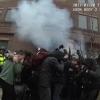DC Police Heed President Trump's Calls for Violence
Democracy in Crisis
Donald Trump’s authoritarian streak has been on full display in recent weeks, nowhere more so than when talking to cops in Long Island.
“Please don’t be too nice,” he said, and told the officers that when they arrest someone, they don’t need to protect the prisoner’s head. “I said, ‘You can take the hand away, OK?’”
Despite the applause and laughter in the room, the line was widely condemned, including by police departments around the country.
White House press secretary Sarah Huckabee Sanders declared it a joke in a press briefing. When asked if police brutality is funny, she said, “Not at all. I think you guys are jumping and trying to make something out of nothing. He was simply making a comment, making a joke.”
This is the kind of joke Trump told at his rallies when he urged his supporters to be rough with protesters and reporters. When he was a candidate, it was violent demagoguery. But now that he is the president—urging members of the police force to commit violence—it is something far more sinister.
Though the “joke” got all the attention, there’s a more interesting and insidious part of Trump’s Long Island speech, in which he also applauded the use of military weaponry by police departments.
“You know, when you wanted to take over and you used military equipment—and they were saying you couldn’t do it—you know what I said? That was my first day: You can do it. In fact, that stuff is disappearing so fast we have none left.”
Trump can be pretty unintelligible and slippery, but it seems like he is either talking about the protests during Inauguration Day or those in Portland, OR on the day after the election. (The White House did not respond to a request for comment by press time). A recent lawsuit filed by the ACLU on behalf of four plaintiffs against Washington, DC’s Metropolitan Police Department details both the use of military weapons and the infliction of post-arrest injury on Inauguration Day.
The DC government has denied a Freedom of Information Act request filed by Democracy in Crisis seeking a list of weapons used against the protesters that day, citing “pending civil and criminal litigation.” But the ACLU lawsuit provides a long list of weapons they believe were deployed by police against protesters, some of whom threw rocks and bottles at police. The list includes pepper spray, smoke flares, concussion grenades, flash-bang grenades (which “produce loud explosive noises and bright flashes of light”), and stingers or stingballs (which are described as “explosive devices that release smoke, rubber pellets and a chemical irritant”).
In video recently obtained by Democracy in Crisis, several officers toss dozens of such devices into crowds of people. In one video, an officer to the far right of the screen tosses a grenade. The camera follows it through the air. It strikes someone in the hip, exploding and knocking them down. Then it appears to hit the ground and bounce up before exploding again on a man’s head (it could be a second device), knocking his red hat off amidst clouds of chemical smoke.
Police have argued that the protesters were part of a “black bloc” conspiracy to destroy property. But neither of the people hit by the grenade were wearing black. The only person in black, to the left of the screen, is wearing a black tracksuit with white stripes and a red hat, looking more like a German tourist than a member of an anarchist conspiracy. It wasn’t a MAGA hat, but it would be hard for a cop to tell from a distance.
Ultimately, more than 200 people were corralled into a kettle, pepper-sprayed and subjected to similar grenades. But what happened after they were in custody, according to the ACLU suit, is even worse. The kind of treatment that Trump was “joking” about “felt like the weirdest horror movie I had ever got stuck inside of,” said Shay Horse, one of the plaintiffs in the ACLU suit, who was arrested while working as a photojournalist on Inauguration Day. Charges against him were later dropped.
“Without warning, Defendant Officer John Doe 150 grabbed Mr. Horse’s testicles and yanked on them,” the complaint reads. “He then put his finger into Mr. Horse’s rectum, through his underwear. As Defendant Officer John Doe 150 pushed his finger into Mr. Horse’s rectum, he ordered Mr. Horse not to flinch.”
The officer, identified as John Doe 150, then did the same thing to another plaintiff, Milo Gonzalez, and others. “Defendant Officer John Doe 150 did not change gloves when he moved from one individual to the next.”
According to the complaint, five to 10 other officers watched this and some of them laughed, just as the officers in Long Island did when Trump told them they didn’t need to protect the heads of prisoners.
Despite Trump’s attempt to take credit for it, none of this behavior is new. In Baltimore, MD, Freddie Gray died after being pushed roughly into a police vehicle, and the Department of Justice report on the city’s police department shows how African Americans, in particular, have been subjected to such degrading treatment for years.
It is new for the president of the United States to encourage such behavior in such a blatant way. And it doesn’t work.
“I’m completely distrustful of anyone in a uniform, any kind of law enforcement person,” said Emily Lagesse, another plaintiff who had never been arrested or in any trouble before. “That is probably like ‘no kidding’ to a lot of people of color, but it is a huge thing for me to feel less safe around people who are supposed to be keeping me safe.”
Keywords
More by Baynard Woods
-

With Much Love and Grim Solidarity, Democracy in Crisis Says Goodbye
Democracy in Crisis
-

Trump Uses the Legal System for His Own Ends
Democracy in Crisis
-

A Mexican Reporter's Death Threats Are the Future of Journalism in America
Democracy in Crisis










comments